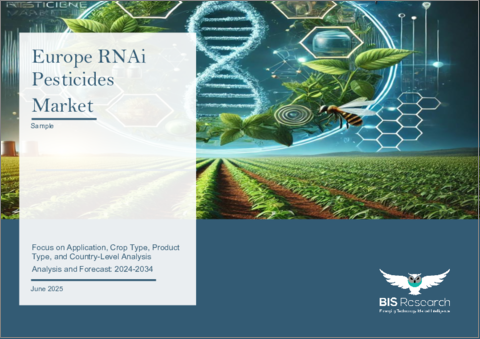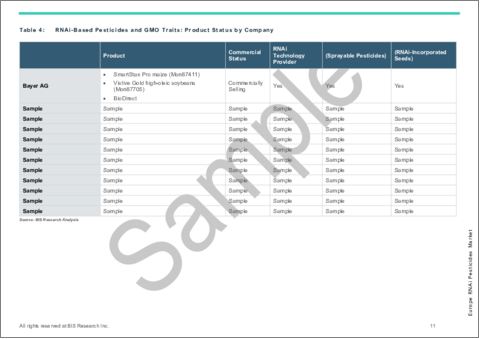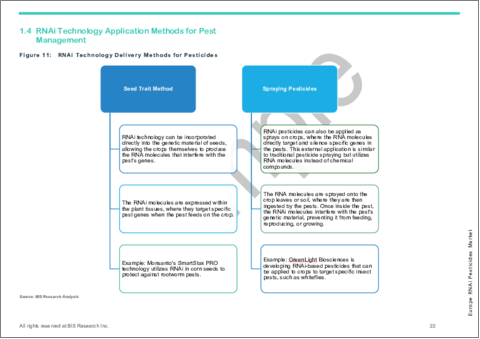|
|
市場調査レポート
商品コード
1748471
欧州のRNAi農薬市場:用途別、作物タイプ別、製品タイプ別、国別 - 分析と予測(2024年~2034年)Europe RNAi Pesticides Market: Focus on Application, Crop Type, Product Type, and Country-Level Analysis - Analysis and Forecast, 2024-2034 |
||||||
カスタマイズ可能
|
|||||||
| 欧州のRNAi農薬市場:用途別、作物タイプ別、製品タイプ別、国別 - 分析と予測(2024年~2034年) |
|
出版日: 2025年06月16日
発行: BIS Research
ページ情報: 英文 68 Pages
納期: 1~5営業日
|
全表示
- 概要
- 図表
- 目次
欧州のRNAi農薬の市場規模は、2024年に1,045万6,700米ドルとなりました。
同市場は、CAGR 16.74%で成長し、2034年には4,914万600米ドルに達すると予測されています。持続可能な農業におけるRNA干渉(RNAi)技術の利用拡大に伴い、欧州市場は着実に拡大しています。バイオテクノロジー、精密農業、総合的害虫管理技術の開発と同様に、従来の化学農薬への依存度を下げることが重視されるようになった結果、市場が拡大しています。環境にやさしい害虫駆除への動きは、EUの規制枠組みや環境意識の高まりも後押ししています。持続可能な農業と生物多様性の保全というこの地域の目標は、継続的な研究開発、戦略的提携、技術の進歩によってもたらされるRNAiベースの作物保護ソリューションの有効性の向上によって達成されつつあります。
市場イントロダクション
| 主要市場統計 | |
|---|---|
| 予測期間 | 2024年~2034年 |
| 2024年の評価 | 1,045万6,700米ドル |
| 2034年予測 | 4,914万600米ドル |
| CAGR | 16.74% |
欧州におけるRNAi農薬市場は、同地域の持続可能な農業の文脈で重要な分野になりつつあります。害虫の特定の遺伝子を沈黙させることで、RNA干渉(RNAi)技術は、環境や他の生物を危険にさらすことなく農業の損失を最小限に抑える、新しい集中的な害虫駆除方法を提供します。この精度は、化学農薬の使用を規制するEUの厳格な法律や、Farm to Fork戦略やグリーン・ディールのようなプログラムを通じて環境に配慮した農業をますます重視する姿勢に沿ったものです。
従来の農薬が環境や健康に与える影響への懸念が高まるなか、RNAiを用いた治療は、その生分解性、選択性、低毒性から支持を集めています。特にドイツ、フランス、オランダなど、バイオテクノロジーと農業革新が確立している国々では、強力な研究開発努力が市場を支えています。効果的な使用とより良い結果を保証することで、デジタルモニタリングや部位別散布技術などの精密農業技術は、RNAi農薬の展開を大幅に改善します。
規制や拡張性の問題にもかかわらず、EUが資金提供する継続的な研究プログラムや、学術機関、農業技術企業、政策立案者間のパートナーシップによって、より広範な導入が促進されています。欧州のRNAi農薬産業は、生態系に優しい食品生産に対する顧客の嗜好、法的支援、技術革新によって、持続可能な作物保護に対する需要の高まりとともに、着実に成長すると予想されます。
市場セグメンテーション
セグメンテーション1:用途別
- RNAi殺虫剤
- RNAi殺菌剤
- RNAi除草剤
セグメンテーション2:作物タイプ別
- 穀物および穀類
- 果物および野菜
- 油糧種子と豆類
セグメンテーション3:製品タイプ別
- 植物組み込み型RNAi技術(遺伝子組み換え形質としてのRNAi)
- 散布型RNAi(局所的RNAi農薬)
セグメンテーション4:地域別
- 欧州ドイツ、フランス、オランダ、英国、ベルギー、その他
欧州のRNAi農薬市場動向と促進要因・課題
動向
- 精密農法や有機農法におけるRNAiベースの作物保護の採用拡大
- 欧州のアグリバイオ企業や学術機関別研究開発投資の増加
- 標的害虫管理のためのRNAiとデジタル農業ツールの統合
- 持続可能な農業イノベーションに焦点を当てた官民連携の増加
- EUが資金提供する生物農薬開発促進イニシアチブの開発拡大
促進要因
- 持続可能で影響の少ない害虫駆除の代替策を求めるEU規制の強い後押し
- 無農薬または残留農薬のない作物に対する消費者および小売業者の需要の高まり
- RNA送達システムや遺伝子サイレンシング技術の技術的進歩
- 従来の化学農薬に対する害虫抵抗性の増加
- EU農業政策における生物多様性保全と生態系の健全性の重視
課題
- RNAi製品の分類と承認をめぐる規制の不確実性
- RNAi農薬の開発・生産コストの高さ
- RNAi技術に対する一般市民の認識や農家への周知が限定的であること
- オフターゲット効果と環境バイオセーフティへの懸念
- 広く普及させるには、地域特有の有効性データが必要
製品/イノベーション戦略:欧州RNAi農薬市場の製品セグメントでは、標的害虫駆除、疾病予防、作物保護などの使用事例に焦点を当て、害虫管理におけるRNAiベースの技術の多様な応用を理解するのに役立ちます。RNAi製剤、生物学的送達システム、遺伝子組み換え技術など、さまざまな技術をカバーしています。バイオテクノロジーの継続的な進歩、投資の増加、環境に優しい害虫駆除に対する意識の高まりにより、RNAi農薬市場は、より持続可能で効果的な害虫管理ソリューションの必要性により、高収益、高投資の機会を提供しています。
成長/マーケティング戦略:欧州のRNAi農薬市場は急速に拡大しており、既存および新興市場参入企業に大きな機会を提供しています。主な戦略としては、M&A、製品上市、パートナーシップ、提携、事業拡大などが挙げられます。この市場の企業は、市場ポジションを維持・強化するため、製品の革新と開発に注力する傾向があります。
競合戦略:当レポートでは、技術プロバイダーやアグリテック企業など、欧州のRNAi農薬市場の主要企業プロファイルを掲載しています。当レポートは、パートナーシップ、契約、提携を含む競合情勢を包括的に捉え、読者が市場において未開拓の収益機会を特定するのに役立ちます。
当レポートでは、欧州のRNAi農薬市場について調査し、市場の概要とともに、用途別、作物タイプ別、製品タイプ別、国別の動向、および市場に参入する企業のプロファイルなどを提供しています。
目次
エグゼクティブサマリー
第1章 市場:業界展望
- 作物のカスタマイズ化の導入拡大
- RNAi殺虫剤は従来の化学農薬に比べて健康と環境へのリスクが軽減される
- サプライチェーンの概要
- 価格分析
- 規制状況
- 研究開発レビュー
- R&D分析
- 特許出願動向(特許庁別・企業別)
- ステークホルダー分析
- 害虫管理におけるRNAi技術の応用方法
- 市場力学:概要
- 市場の促進要因
- 市場の抑制要因
- 市場の機会
第2章 地域
- 地域のサマリー
- 欧州
- 地域概要
- 市場成長促進要因
- 市場成長抑制要因
- 用途
- 製品
- 欧州(国別)
第3章 市場-競合ベンチマーキングと企業プロファイル
- 今後の見通し
- 戦略的取り組みと市場シェア
- テクノロジープロバイダーおよび製品メーカー
- Bayer AG
- Syngenta
- TROPIC
第4章 調査手法
List of Figures
- Figure 1: Europe RNAi Pesticides Market (by Scenario), $Thousand, 2023, 2027, and 2034
- Figure 2: RNAi Pesticides Market (by Region), $Thousand, 2023, 2027, and 2034
- Figure 3: Europe RNAi Pesticides Market (by Application), $Thousand, 2023, 2027, and 2034
- Figure 4: Europe RNAi Pesticides Market (by Crop Type), $Thousand, 2023, 2027, and 2034
- Figure 5: Europe RNAi Pesticides Market (by Product Type), $Thousand, 2023, 2027, and 2034
- Figure 6: Key Events
- Figure 7: Key Developments in Crop Customization
- Figure 8: Global Impact of Pesticide Poisoning on Farmers
- Figure 9: Supply Chain and Risks within the Supply Chain
- Figure 10: Pricing Analysis for the RNAi Pesticides Market, Metric Ton/$)
- Figure 11: Patent Analysis (by Patent Office), January 2021-February 2025
- Figure 12: Patent Analysis (by Company), January 2021-February 2025
- Figure 13: Technology Providers' Role and Interests
- Figure 14: Agrochemical Companies Role and Interests
- Figure 15: Seed Manufacturers' Role and Interests
- Figure 16: Research Organizations' Role and Interests
- Figure 17: Seed Manufacturers' Role and Interests
- Figure 18: RNAi Technology Delivery Methods for Pesticides
- Figure 19: Impact Analysis of Market Navigating Factors, 2024-2034
- Figure 20: Organic Agriculture Ecosystem
- Figure 21: Global Pesticides Usage, in Tons, 2019-2022
- Figure 22: Comparative Pricing Analysis of Regular Pesticides and RNAi Pesticides (by Region), $/kg, 2024
- Figure 23: Germany RNAi Pesticides Market, $Thousand, 2023-2034
- Figure 24: France RNAi Pesticides Market, $Thousand, 2023-2034
- Figure 25: U.K. RNAi Pesticides Market, $Thousand, 2023-2034
- Figure 26: Netherlands RNAi Pesticides Market, $Thousand, 2023-2034
- Figure 27: Belgium RNAi Pesticides Market, $Thousand, 2022-2034
- Figure 28: Rest-of-Europe RNAi Pesticides Market, $Thousand, 2023-2034
- Figure 29: Strategic Initiatives, January 2022-December 2025
- Figure 30: Share of Strategic Initiatives, 2023
- Figure 31: Data Triangulation
- Figure 32: Top-Down and Bottom-Up Approach
- Figure 33: Assumptions and Limitations
List of Tables
- Table 1: Market Snapshot
- Table 2: Opportunities across Region
- Table 3: Competitive Landscape Snapshot
- Table 4: RNAi-Based Pesticides and GMO Traits: Product Status by Company
- Table 5: Global Trends in the RNAi Pesticides Market
- Table 6: List of Regulations for the RNAi Pesticides Market
- Table 7: Research and Development Funding Analysis for RNAi Pesticides Market
- Table 8: RNAi Pesticides Market (by Region), $Thousand, 2023-2034
- Table 9: Europe RNAi Pesticides Market (by Application), $Thousand, 2023-2034
- Table 10: Europe RNAi Pesticides Market (by Crop Type), $Thousand, 2023-2034
- Table 11: Europe RNAi Pesticides Market (by Product), $Thousand, 2023-2034
- Table 12: Germany RNAi Pesticides Market (by Application), $Thousand, 2023-2034
- Table 13: Germany RNAi Pesticides Market (by Crop Type), $Thousand, 2023-2034
- Table 14: Germany RNAi Pesticides Market (by Product), $Thousand, 2023-2034
- Table 15: France RNAi Pesticides Market (by Application), $Thousand, 2023-2034
- Table 16: France RNAi Pesticides Market (by Crop Type), $Thousand, 2023-2034
- Table 17: France RNAi Pesticides Market (by Product), $Thousand, 2023-2034
- Table 18: U.K. RNAi Pesticides Market (by Application), $Thousand, 2023-2034
- Table 19: U.K. RNAi Pesticides Market (by Crop Type), $Thousand, 2023-2034
- Table 20: U.K. RNAi Pesticides Market (by Product), $Thousand, 2023-2034
- Table 21: Netherlands RNAi Pesticides Market (by Application), $Thousand, 2023-2034
- Table 22: Netherlands RNAi Pesticides Market (by Crop Type), $Thousand, 2023-2034
- Table 23: Netherlands RNAi Pesticides Market (by Product), $Thousand, 2023-2034
- Table 24: Belgium RNAi Pesticides Market (by Application), $Thousand, 2023-2034
- Table 25: Belgium RNAi Pesticides Market (by Crop Type), $Thousand, 2023-2034
- Table 26: Belgium RNAi Pesticides Market (by Product), $Thousand, 2023-2034
- Table 27: Rest-of-Europe RNAi Pesticides Market (by Application), $Thousand, 2023-2034
- Table 28: Rest-of-Europe RNAi Pesticides Market (by Crop Type), $Thousand, 2023-2034
- Table 29: Rest-of-Europe RNAi Pesticides Market (by Product), $Thousand, 2023-2034
- Table 30: Market Share, 2023
- Table 31: Company Development
Introduction to Europe RNAi Pesticides Market
The Europe RNAi pesticides market was valued at $10,456.7 thousand in 2024 and is expected to grow at a CAGR of 16.74%, reaching $49,140.6 thousand by 2034. With the growing use of RNA interference (RNAi) technology in sustainable agriculture, the European market is expanding steadily. The market is expanding as a result of growing emphasis on lowering dependency on traditional chemical pesticides as well as developments in biotechnology, precision farming, and integrated pest management techniques. The move towards environmentally friendly pest control options is also being aided by supportive EU regulatory frameworks and increased environmental consciousness. The region's objectives for sustainable farming and biodiversity conservation are being met by the increasing effectiveness of RNAi-based crop protection solutions brought about by ongoing research and development, strategic alliances, and technological advancements.
Market Introduction
| KEY MARKET STATISTICS | |
|---|---|
| Forecast Period | 2024 - 2034 |
| 2024 Evaluation | $10,456.7 Thousand |
| 2034 Forecast | $49,140.6 Thousand |
| CAGR | 16.74% |
The market for RNAi pesticides in Europe is becoming a significant area in the context of sustainable agriculture in the region. Through the silence of particular genes in pests, RNA interference (RNAi) technology provides a new, focused method of pest control that minimises agricultural loss without endangering the environment or other organisms. This accuracy is in line with the European Union's strict laws governing the use of chemical pesticides and its increasing emphasis on environmentally responsible farming through programs like the Farm to Fork Strategy and the Green Deal.
As worries about the environmental and health effects of conventional pesticides grow, RNAi-based treatments are gaining traction because to their biodegradability, selectivity, and low toxicity. Strong R&D efforts assist the market, especially in nations with established biotechnology and agricultural innovation, such Germany, France, and the Netherlands. By guaranteeing effective use and better results, precision agriculture techniques, including as digital monitoring and site-specific application technologies, significantly improve the deployment of RNAi pesticides.
Broader adoption is being facilitated by ongoing EU-funded research programs and partnerships between academic institutions, agri-tech enterprises, and policymakers, despite regulatory and scalability issues. The European RNAi pesticide industry is expected to increase steadily as customer preferences for ecologically friendly food production, legislative assistance, and innovation drive the growing demand for sustainable crop protection.
Market Segmentation:
Segmentation 1: by Application
- RNAi Insecticide
- RNAi Fungicide
- RNAi Herbicide
Segmentation 2: by Crop Type
- Cereals and Grains
- Fruits and Vegetables
- Oilseed and Pulses
Segmentation 3: by Product Type
- Plant-Incorporated RNAi Technology (RNAi as a GMO Trait)
- Sprayable RNAi (Topical RNAi Pesticides)
Segmentation 4: by Region
- Europe: Germany, France, Netherlands, U.K., Belgium, and Rest-of-Europe
Europe RNAi Pesticide Market Trends, Drivers and Challenges
Trends
- Growing adoption of RNAi-based crop protection in precision and organic farming practices
- Increasing R&D investment by European agri-biotech firms and academic institutions
- Integration of RNAi with digital farming tools for targeted pest management
- Rise in public-private collaborations focused on sustainable agriculture innovation
- Expansion of EU-funded initiatives promoting biopesticide development
Drivers
- Strong EU regulatory push for sustainable and low-impact pest control alternatives
- Rising consumer and retailer demand for pesticide-free or residue-free crops
- Technological advancements in RNA delivery systems and gene-silencing techniques
- Increased pest resistance to conventional chemical pesticides
- Emphasis on biodiversity preservation and ecosystem health in EU agricultural policy
Challenges
- Regulatory uncertainty surrounding the classification and approval of RNAi products
- High development and production costs of RNAi pesticides
- Limited public awareness and farmer familiarity with RNAi technology
- Concerns over off-target effects and environmental biosafety
- Need for region-specific efficacy data to support widespread adoption
How can this report add value to an organization?
This report can add value to an organization in several ways. Some of these are given here:
Product/Innovation Strategy: The product segment of the Europe RNAi pesticides market helps readers understand the diverse applications of RNAi-based technologies in pest management, focusing on use cases such as targeted pest control, disease prevention, and crop protection. It covers various technologies, including RNAi formulations, biological delivery systems, and genetic modification techniques. With ongoing advancements in biotechnology, increased investments, and rising awareness about eco-friendly pest control, the RNAi pesticides market offers a high-revenue, high-investment opportunity driven by the need for more sustainable and effective pest management solutions.
Growth/Marketing Strategy: The Europe RNAi pesticides market is rapidly expanding, offering substantial opportunities for both established and emerging market players. Key strategies covered include mergers and acquisitions, product launches, partnerships, collaborations, and business expansions. Companies in this market tend to focus on product innovation and development to maintain and strengthen their market position.
Competitive Strategy: The report profiles key players in the Eruope RNAi pesticides market, including technology providers and Agri-Tech companies. It offers a comprehensive view of the competitive landscape, including partnerships, agreements, and collaborations, helping readers identify untapped revenue opportunities in the market.
Key Market Players and Competition Synopsis
The companies that are profiled in the Europe RNAi pesticides market have been selected based on inputs gathered from primary experts, who have analyzed company coverage, product portfolio, and market penetration.
Some of the prominent names in this market are:
- Bayer AG
- Syngenta
- TROPIC
Table of Contents
Executive Summary
Scope and Definition
1 Market: Industry Outlook
- 1.1.1 Growing Adoption of Crop Customization Practices
- 1.1.2 Reduced Health and Environmental Risks with RNAi Pesticides Compared to Conventional Chemicals
- 1.2 Supply Chain Overview
- 1.2.1 Pricing Analysis
- 1.3 Regulatory Landscape
- 1.4 Research and Development Review
- 1.4.1 R&D Analysis
- 1.4.2 Patent Filing Trend (by Patent Office and Company)
- 1.5 Stakeholder Analysis
- 1.6 RNAi Technology Application Methods for Pest Management
- 1.7 Market Dynamics: Overview
- 1.7.1 Market Drivers
- 1.7.1.1 Increase in the Area of Organic Agricultural Land
- 1.7.1.2 Increase in the Emergence of Pest Variants
- 1.7.2 Market Restraints
- 1.7.2.1 Elevated Costs Associated with RNAi Pesticides
- 1.7.3 Market Opportunities
- 1.7.3.1 Rise in Consumer Demands for Chemical-Free Products
- 1.7.3.2 Partnership with Agrochemical Companies
- 1.7.1 Market Drivers
2 Region
- 2.1 Regional Summary
- 2.2 Europe
- 2.2.1 Regional Overview
- 2.2.2 Driving Factors for Market Growth
- 2.2.3 Factors Challenging the Market
- 2.2.4 Application
- 2.2.5 Product
- 2.2.6 Europe (by Country)
- 2.2.6.1 Germany
- 2.2.6.1.1 Application
- 2.2.6.1.2 Product
- 2.2.6.2 France
- 2.2.6.2.1 Application
- 2.2.6.2.2 Product
- 2.2.6.3 U.K.
- 2.2.6.3.1 Application
- 2.2.6.3.2 Product
- 2.2.6.4 Netherlands
- 2.2.6.4.1 Application
- 2.2.6.4.2 Product
- 2.2.6.5 Belgium
- 2.2.6.5.1 Application
- 2.2.6.5.2 Product
- 2.2.6.6 Rest-of-Europe
- 2.2.6.6.1 Application
- 2.2.6.6.2 Product
- 2.2.6.1 Germany
3 Markets - Competitive Benchmarking and Company Profiles
- 3.1 Next Frontiers
- 3.2 Strategic Initiatives and Market Share
- 3.3 Technology Provider and Product Manufacturer
- 3.3.1 Bayer AG
- 3.3.1.1 Overview
- 3.3.1.2 Top Products/Product Portfolio
- 3.3.1.3 Top Competitors
- 3.3.1.4 Target Customers/End Users
- 3.3.1.5 Key Personnel
- 3.3.1.6 Analyst View
- 3.3.2 Syngenta
- 3.3.2.1 Overview
- 3.3.2.2 Top Products/Product Portfolio
- 3.3.2.3 Top Competitors
- 3.3.2.4 Target Customers/End Users
- 3.3.2.5 Key Personnel
- 3.3.2.6 Analyst View
- 3.3.3 TROPIC
- 3.3.3.1 Overview
- 3.3.3.2 Top Products/Product Portfolio
- 3.3.3.3 Top Competitors
- 3.3.3.4 Target Customers/End Users
- 3.3.3.5 Key Personnel
- 3.3.3.6 Analyst View
- 3.3.1 Bayer AG
4 Research Methodology
- 4.1 Data Sources
- 4.1.1 Primary Data Sources
- 4.1.2 Secondary Data Sources
- 4.1.3 Data Triangulation
- 4.2 Market Estimation and Forecast






